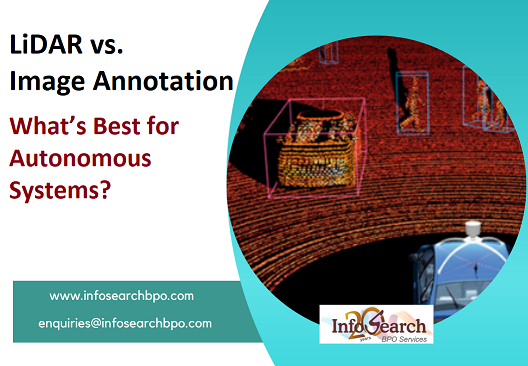Contact Infosearch for Lidar and Image Annotations:
Infosearch provides both image annotation services and LiDAR annotations for autonomous vehicles to deliver the accurate datasets. Outsource autonomous vehicles annotations to Infosearch to train machine learning models.
Self-driving vehicles, drones and robots are examples of autonomous systems that are based on perception technologies to explore complex environments. To do this, they need to make correct and real-time interpretations of voluminous sensory information. This is possible by two major sources of data, LiDAR (Light Detection and Ranging) and camera imagery. They both give different perspectives on the world, but they both rely on the accuracy of data annotation to offer good machine learning models.
Then, what is superior to autonomous systems LiDAR annotation or image annotation? The solution to this lies in the application, environment and the degree of accuracy needed.
What is LiDAR Annotation?
LiDAR sensors scan the surroundings with laser pulses that record the distance of the objects surrounding. This gives a three-dimensional point cloud, which is an accurate depiction of depth, shape, and distance. The LiDAR data is annotated by marking these points in order to discover the roads, vehicles, pedestrians, and obstacles as well as other objects that are essential in navigation.
LiDAR annotation has the following benefits:
- Correct depth perception: LiDAR ensures that the data is accurate and the distances and shapes are clear including low-light or nighttime.
- Robust object location: It is the best at determining object edges and the 3D spatial correlation.
- Critical to localization: LiDAR assists autonomous vehicles to map and be able to locate themselves with a level of precision of centimeters.
LiDAR annotation is however complicated and resource-consuming. The data of a point cloud is huge, and it is necessary to label every 3D object with the help of specific tools and professional annotators. Besides, LiDAR information is without texture and color and thus classifying some objects is more difficult than in the case of image data.
What is Image Annotation?
Cameras on the other offer abundant visual information which captures the color, texture and small details. Image annotation refers to the process of labeling objects, lanes, traffic signs, and other visual objects like with bounding boxes, semantic segmentation, and key point annotation.
The benefits of image annotation are:
- Extensive visual background: Cameras are able to identify indicators, lights, and surface features which are not able to be captured by LiDAR.
- Low cost: Compared to LiDAR sensors, cameras are less expensive and more common.
- Advanced annotation technology: Image labelling systems have been established, enabling to process data faster.
However, there are some constraints of image annotation, especially in adverse conditions: low light, mist or glare. Cameras alone cannot be very accurate in estimating distances without depth perception.
The synthesis of LiDAR and Image Annotation to achieve Excellent Performance.
The most sophisticated autonomous systems do not depend on one sensor only. They do not, but rely on sensor fusion, which is a combination of LiDAR and camera data to formulate an (almost) complete picture of the surrounding.
This is because AI models are able to identify, classify and track objects more accurately under any type of conditions by using 3D LiDAR annotations along with 2D image annotations.
As an example, LiDAR has spatial, whereas camera images have contextual information. Combined, these data sets can provide better obstacle avoidance, lane tracking and decision-making functionality, all needed to provide safe and secure autonomy.
Conclusion
The choice between LiDAR and image annotation is not one of choosing one more and the other one less: it is about the realization of how the two are supplementary to each other. LiDAR is highly accurate in depth and spatial resolution and image annotation provides visual intelligence and context to LiDAR.
In the case of those businesses who are creating autonomous vehicles, robotics, or mapping software, the quality of LiDAR and image data annotation will provide a more robust, precise, and intelligent perception system. The future of autonomy lies not only in the sensors, but in the effectiveness of the mechanism of annotating and interpreting the information produced by the sensors.
Contact Infosearch for your data annotation services.








Recent Comments